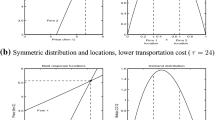Abstract
Relevant market definition remains a key element in the economic analysis of competition in the gasoline market. However, this is particularly difficult to undertake when competition is local and market power is geographically constrained, as they are in the case of the gasoline market. We analyse how the hypothetical monopolist or Small but Significant Non-Transitory Increase in Prices test performs when defining isochrones based solely on price information and the distance between competitors. We conclude that geographic information systems can be successfully employed in the precise definition of relevant geographic markets in the gasoline retail sector. Their application to the Spanish gasoline market indicates that the relevant geographic market is delineated by a 5- to 6-min travel-time isochrone around each station. Localized market power needs to be taken into account when analysing the adverse effects of mergers and entry regulations on gasoline retailing. To drive competition in these local circumstances, markets need to be delineated on the basis of sufficiently small isochrones since only close rivals seem to compete effectively with each other.


Similar content being viewed by others
Notes
The effect of any difference in resident income across market is equivalent to the effect of a market expansion: it would drive higher prices and markups up to the point in which it would drive more entrants into the market (see Table 1).
Results not change if we take into account price with taxes because the taxation is the same for all the petrol stations.
Results include the variable number of rivals squared is in “Annex 1”. We can see like results are less precise because there is not a large heterogeneity of number of rivals between petrol stations, so the two variables are very similar.
The results are not significantly altered if we consider that traffic as a demand factor can also influence the equilibrium price. If there are barriers to entry that deter new operators when the traffic increases, then traffic may explain prices rather than the number of entrants.
References
Anderson S, de Palma A, Thisse J-F (1992) Discrete choice theory of product differentiation. The MIT Press, Massachusetts
Argentesi E, Ivaldi M (2007) Market definition in the printed media industry: theory, practice and lessons for broadcasting. In: Seabright P, Von Hagen J (eds) The economic regulation of broadcasting markets. Cambridge University Press, Cambridge, pp 225–252
Audy E, Erutku C (2005) Price test to define markets: an application to wholesale gasoline in Canada. J Ind Compet Trade 5:137–154. https://doi.org/10.1007/s10842-005-3721-1
Bajari P, Hong H, Krainer J, Nekipelov D (2010) Estimating static games of strategic interaction. J Bus Econ Stat 28(4):469–489. https://doi.org/10.1198/jbes.2009.07264
Baker J (1999) Econometric analysis in FTC vs staples. J Public Policy Mark 18:11–21
Berry S (1994) Estimating discrete choice models of product differentiation. RAND J Econ 25(2):242–262
Berry S, Levinsohn J, Pakes A (1995) Automobile prices in market equilibrium. Econometrica 63:841–890
Brenkers R, Verboven F (2006) Market definition with differentiated products: lessons from the car market. In: Choi JP (ed) Recent developments in antitrust: theory and evidence. The MIT Press, Massachusetts
Campbell JR, Hopenhayn HA (2005) Market size matters. J Ind Econ 53:1–25
Competition Commission (2003 September) Safeway plc and Asda group limited: a report on the mergers in contemplation
Contin I, Correljé A, Huerta E (1998) Estrategias de Fijación de Precios en el Mercado Español de la Gasolina (1990–1997) Factores Explicativos. Econ Ind 321:35–46
Ivaldi M, Lörincz S (2011) Implementation relevant market test: application to computer servers. Rev Law Econ 7(1):31–73. https://doi.org/10.2202/1555-5879.1248
Office of Fair Trading (2005) Acquisition by Terra Firma Investments (GP) 2 Ltd of United Cinemas International (UK) Limited and Cinema International Corporation (UK) Limited
Pinkse J, Slade ME, Brett C (2002) Spatial price competition: a semiparametric approach. Econometrica 70:1111–1153
Sharma K (2011) SSNIP test: a useful tool, not a panacea. Compet Law Rep 178:188–192
Spiller PT, Huang CF (1986) On the extent of the market: wholesale gasoline in the northeastern United States. J Ind Econ 35:131–145
Staiger D, Stock JH (1997) Instrumental variables regression with weak instruments. Econometrica 65:557–586
Stock JH, Yogo M (2002) Testing for weak instruments in linear IV regression. NBER technical working paper series, no. 284
Acknowledgements
Jordi Perdiguero thanks the funding received from Fundación Rafael del Pino, and Joan Ramon Borrell thanks the funding received from the Catalan competition authority (Tribunal Català de Defensa de la Competencia, TDCD). Both authors thank the comments and suggestions from the members of the TCDC, the participants at the Encuentro de Economia Aplicada and EARIE 2007, and the funding received from RECERCAIXA. We thank the excellent research assistance in the use of geographic information systems by Adrià Botey.
Author information
Authors and Affiliations
Corresponding author
Annex 1: Estimations with the variable number of rivals squared
Rights and permissions
About this article
Cite this article
Perdiguero, J., Borrell, J.R. Driving competition in local markets with near-perfect substitutes: an application on the Spanish retail gasoline market. Empir Econ 57, 345–364 (2019). https://doi.org/10.1007/s00181-018-1427-6
Received:
Accepted:
Published:
Issue Date:
DOI: https://doi.org/10.1007/s00181-018-1427-6




